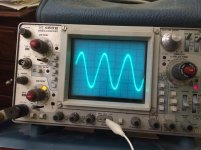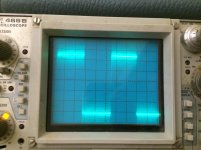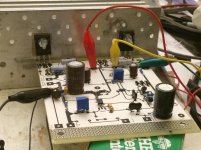My interest is driven SICFET parallel with a permanently OFF silicon superjunction.
I actually want the most non-linear DS capacitance curve possible (IE: Infineon C7).
And a SICFET by itself just won't give that to me...
Goal is ZVSwitched audio. But the most non-linear Superjunction MOSFET I can buy
doesn't switch fast enough, and the fastest SICFET I can buy doesn't have enough
capacitance for soft turn-off. Adding more linear capacitance aggravates cap discharge
losses at turn-on, or necessitates leaky transformer aggravating turn-off. Thus I want
most severe C(TR)/C(ER) as my figure of merit. Most voltage rise time delay for least
stored energy at full charge.
I think parallel of these dissimilar FETS might achieve it. Also offers the silicon clamp
voltage -0.7V rather than SIC -4V. Zero voltage switching is a misnomer that should
be called "Negative Zero Point Seven Volt Switching". Not worried the Silicon body
diode recovery, because that freewheel diode is shorted into recovery by the driven
SICFET long before freewheeling ends.
Just a little weird that I want a Silicon Superjuction, only to wire it OFF and abuse
as high voltage non-linear cap and diode. This is not behavior any sane individual
would want in a normal audio amp.
As for what I'm doing about ZVS at light load is outside the scope of SIC discussion.
I actually want the most non-linear DS capacitance curve possible (IE: Infineon C7).
And a SICFET by itself just won't give that to me...
Goal is ZVSwitched audio. But the most non-linear Superjunction MOSFET I can buy
doesn't switch fast enough, and the fastest SICFET I can buy doesn't have enough
capacitance for soft turn-off. Adding more linear capacitance aggravates cap discharge
losses at turn-on, or necessitates leaky transformer aggravating turn-off. Thus I want
most severe C(TR)/C(ER) as my figure of merit. Most voltage rise time delay for least
stored energy at full charge.
I think parallel of these dissimilar FETS might achieve it. Also offers the silicon clamp
voltage -0.7V rather than SIC -4V. Zero voltage switching is a misnomer that should
be called "Negative Zero Point Seven Volt Switching". Not worried the Silicon body
diode recovery, because that freewheel diode is shorted into recovery by the driven
SICFET long before freewheeling ends.
Just a little weird that I want a Silicon Superjuction, only to wire it OFF and abuse
as high voltage non-linear cap and diode. This is not behavior any sane individual
would want in a normal audio amp.
As for what I'm doing about ZVS at light load is outside the scope of SIC discussion.
I'm pretty sure I don't completely follow your question. It is a very interesting application for these devices though. So if I understand , you are using the silicon device as a non linear capacitance and silicon diode? The mosfet part never turns on? The devices are connected gate to gate Drain to drain and source to source? Is the circuit a type of multiplexer ? Just trying to understand what you are working with.My interest is driven SICFET parallel with a permanently OFF silicon superjunction.
I actually want the most non-linear DS capacitance curve possible (IE: Infineon C7).
And a SICFET by itself just won't give that to me...
Goal is ZVSwitched audio. But the most non-linear Superjunction MOSFET I can buy
doesn't switch fast enough, and the fastest SICFET I can buy doesn't have enough
capacitance for soft turn-off. Adding more linear capacitance aggravates cap discharge
losses at turn-on, or necessitates leaky transformer aggravating turn-off. Thus I want
most severe C(TR)/C(ER) as my figure of merit. Most voltage rise time delay for least
stored energy at full charge.
I think parallel of these dissimilar FETS might achieve it. Al
Just a little weird that I want a Silicon Superjuction, only to wire it OFF and abuse
as high voltage non-linear cap and diode. This is not behavior any sane individual
would want in a normal audio amp.
As for what I'm doing about ZVS at light load is outside the scope of SIC discussion.
The silicon superjunction is shorted gate to source, permanently OFF.
Only the SICFET gate is driven, drain and source otherwise in parallel.
Both types offer similar RDSon. Both in parallel tempts twice conductive.
But they want considerably different gate voltages and timing, and the
Si could only come into play for a small part of the longest duty cycles.
Not so much return for the added effort of driving it, just leave it off...
I just need to trap SICFET drain to a reasonably low voltage till the gate
has been driven completely off. Remember an inductor is hammering this
drain with stored current and trying to shoot voltage to the other rail.
Which is exactly what I do want, just not right away...
The superjunction drain can absorb 5uJ into many nanofarads below 20V.
Above this knee, capacitance drops to a hunded picos or so. Very similar
energy storage to SIC, but the curve of the voltage rise is way different
and very usefully delayed at the low end.
A linear capacitor might allow soft turn-off, but stores too much energy.
Need more inductor for soft turn-on. Need more cap for soft turn-off.
Need more inductor for soft turn-on. Need more cap for soft turn-off.
Need more inductor for soft turn-on. Need more cap for soft turn-off.
Its not endless, you eventually do win for both edges. But resonating
so slowly you didn't gain any switching rate, what was the point???
A nonlinear capacitor offers a way out of that dilemma while staying fast.
They don't make or sell such a non-linear capcitor, except they do, and
its called a Silicon Superjunction MOSFET.
Only the SICFET gate is driven, drain and source otherwise in parallel.
Both types offer similar RDSon. Both in parallel tempts twice conductive.
But they want considerably different gate voltages and timing, and the
Si could only come into play for a small part of the longest duty cycles.
Not so much return for the added effort of driving it, just leave it off...
I just need to trap SICFET drain to a reasonably low voltage till the gate
has been driven completely off. Remember an inductor is hammering this
drain with stored current and trying to shoot voltage to the other rail.
Which is exactly what I do want, just not right away...
The superjunction drain can absorb 5uJ into many nanofarads below 20V.
Above this knee, capacitance drops to a hunded picos or so. Very similar
energy storage to SIC, but the curve of the voltage rise is way different
and very usefully delayed at the low end.
A linear capacitor might allow soft turn-off, but stores too much energy.
Need more inductor for soft turn-on. Need more cap for soft turn-off.
Need more inductor for soft turn-on. Need more cap for soft turn-off.
Need more inductor for soft turn-on. Need more cap for soft turn-off.
Its not endless, you eventually do win for both edges. But resonating
so slowly you didn't gain any switching rate, what was the point???
A nonlinear capacitor offers a way out of that dilemma while staying fast.
They don't make or sell such a non-linear capcitor, except they do, and
its called a Silicon Superjunction MOSFET.
Last edited:
Kenpeter
Wow, you are way beyond my level of understanding ! I appreciate you explaining to me the situation you have and your ideas to address it. Hopefully someone here who reads this will be of some help to you . I wish I could have. I do much admire those who can think out of the box and use components in new and unusual ways. My hat is off to you!
Best...
Wow, you are way beyond my level of understanding ! I appreciate you explaining to me the situation you have and your ideas to address it. Hopefully someone here who reads this will be of some help to you . I wish I could have. I do much admire those who can think out of the box and use components in new and unusual ways. My hat is off to you!
Best...
Last edited:
Well, it didn't start as an audio project. Plan was 2KW inverter
for Google Littlebox Contest. But I blew the deadline to have it
all working and documented... Can make any waveform, so why
not an audio amp? Most of it is still in simulations, aside from all
the magnetic cores I've glued up and wound and measured in
attempt to train myself the mysterious black art of magnetics.
Only then to discover I had to train up from complete ignorance
about soft switching. It was contest requirement 95% efficiency
at all loads that could not be realized with ordinary hard switching.
Not even with Cree's best, or any of the GAN from unmentionable
sources that was teased my way but never delivered. I had to
build my own unobtanium from whatever Digikey had in stock,
thus the wacky plan to combine Cree SIC with Infineon C7...
2KW sine into a resistor varies from 0W to 4KW at any instant.
Just about impossible to assure ZVS over such a huge load range.
So, yeah. I was massively late getting a viable plan together...
Anyways, no more about this here. I hadn't noticed that I had
wandered into PASS' corner in search of posts about SIC.
for Google Littlebox Contest. But I blew the deadline to have it
all working and documented... Can make any waveform, so why
not an audio amp? Most of it is still in simulations, aside from all
the magnetic cores I've glued up and wound and measured in
attempt to train myself the mysterious black art of magnetics.
Only then to discover I had to train up from complete ignorance
about soft switching. It was contest requirement 95% efficiency
at all loads that could not be realized with ordinary hard switching.
Not even with Cree's best, or any of the GAN from unmentionable
sources that was teased my way but never delivered. I had to
build my own unobtanium from whatever Digikey had in stock,
thus the wacky plan to combine Cree SIC with Infineon C7...
2KW sine into a resistor varies from 0W to 4KW at any instant.
Just about impossible to assure ZVS over such a huge load range.
So, yeah. I was massively late getting a viable plan together...
Anyways, no more about this here. I hadn't noticed that I had
wandered into PASS' corner in search of posts about SIC.
Yes. H bridge of four units such as you drew.
The choke is center tapped. Ask me why in another thread.
The choke is center tapped. Ask me why in another thread.
Hello kenpeter. I searched forums using 'Silicon Superjunction Mosfet' and came out empty; except its mention here. Please suggest the name of this other thread which I likely missed. Your suggested audio application switched interest. Thanks.Yes. H bridge of four units such as you drew.
The choke is center tapped. Ask me why in another thread.
Hello kenpeter.
Lots of knowledge via Google searches. The Conclusion part of a Vishay Application noted that SJ Mosfets have a highly non-linear output capacitance...
Hello to those still around...
I finally got around to building an audio amplifier with the CREE C2M1000170D SIC mosfets.
Only on the bench so far, driven by my sine generator, but they bias up like a dream and look great on my scope. The photos are of the output of a 30 volt peak to peak 20 kiloHertz sine wave, a 3 volt 1 kiloHz square wave, and the circuit in action. The 150 kHz sine is down about 12 percent from flat response portion of bandwidth. I was worried that the low capacitance of these devices would be a problem for me in this circuit, but it is very stable. Bias is rock steady after warm up stabilization. I'm relieved and very happy they are out of their tube and in operation.
I finally got around to building an audio amplifier with the CREE C2M1000170D SIC mosfets.
Only on the bench so far, driven by my sine generator, but they bias up like a dream and look great on my scope. The photos are of the output of a 30 volt peak to peak 20 kiloHertz sine wave, a 3 volt 1 kiloHz square wave, and the circuit in action. The 150 kHz sine is down about 12 percent from flat response portion of bandwidth. I was worried that the low capacitance of these devices would be a problem for me in this circuit, but it is very stable. Bias is rock steady after warm up stabilization. I'm relieved and very happy they are out of their tube and in operation.
Attachments
Last edited:
2 PicoDumbs
Thanks for the complement! I can't wait to hear about your new find....
Thanks for the complement! I can't wait to hear about your new find....
I recently discovered some interesting devices.
I'm currently trying to order some.
Very nice and clever to use paper template to guide you in the build like it a lot.
I'm now just on the final build with the F6 using the Crees and since I am using the high speed buffer chip at the front end with a +- 20 volt DC power supply I'm using the same 20 volts for the reference with a divider to provide stable voltage for the gate. I had been monitoring the voltage movement even with the zeners and did not like what I saw when the amp driven hard. Leds were a little more stable but since I have a rock solid power supply for the buffer chip that will be the final build. The amp still sounds fantastic but have not done a comparison with the prototype with zeners and without but will report back.
I see picodumbs is teasing us with his new find hopefully these are the next R100's.
I'm now just on the final build with the F6 using the Crees and since I am using the high speed buffer chip at the front end with a +- 20 volt DC power supply I'm using the same 20 volts for the reference with a divider to provide stable voltage for the gate. I had been monitoring the voltage movement even with the zeners and did not like what I saw when the amp driven hard. Leds were a little more stable but since I have a rock solid power supply for the buffer chip that will be the final build. The amp still sounds fantastic but have not done a comparison with the prototype with zeners and without but will report back.
I see picodumbs is teasing us with his new find hopefully these are the next R100's.
Very nice and clever to use paper template to guide you in the build like it a lot.
I'm now just on the final build with the F6 using the Crees and since I am using the high speed buffer chip at the front end with a +- 20 volt DC power supply I'm using the same 20 volts for the reference with a divider to provide stable voltage for the gate. I had been monitoring the voltage movement even with the zeners and did not like what I saw when the amp driven hard. Leds were a little more stable but since I have a rock solid power supply for the buffer chip that will be the final build. The amp still sounds fantastic but have not done a comparison with the prototype with zeners and without but will report back.
I see picodumbs is teasing us with his new find hopefully these are the next R100's.
Hi formantjim
Thanks. Glad you like it. Good to know these devices are sounding good in operation. I hope to listen more myself soon, but early indications are these will be useful for Papa style amps. It just occurred to me that there are no P-channel versions of these devices. That makes using them interesting because it makes it necessary to use unipolar designs like the F6.
Hi formantjim
Thanks. Glad you like it. Good to know these devices are sounding good in operation. I hope to listen more myself soon, but early indications are these will be useful for Papa style amps. It just occurred to me that there are no P-channel versions of these devices. That makes using them interesting because it makes it necessary to use unipolar designs like the F6.
Are you running a Mu type of circuit with these devices?
- Home
- Amplifiers
- Pass Labs
- new SiC JFETs?



